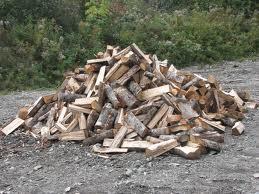
There is an unspoken problem with typical withdrawal strategies for a retirement portfolios that are timed to spend down to zero when the investor dies (or perhaps a few years safety). And the problem is related to the problem of what is “enough”.
This analogy comes from Tommy Angelo (of Tiltless fame). Tommy is a wordsmith, philosopher, musician, and poker player. I have adapted his analogy below (he gives explicit permission on his website to do this) – but I cut out the poker stuff. If you want to read the whole thing, it’s at: http://tommyangelo.com/articles/enough-is-not-enough/ .
One night when I was camping, I was sitting by the fire — a fire that was in no jeopardy whatsoever of being underfed — when it occurred to me that my relationship to firewood while camping is the same as my relationship to money. I severely and drastically do not want to run out of either one.
And it turns out there is a scientific theoretical mathematical relationship at play as well. To camp, all I need is time and wood. To live, all I need is time and money. Do the algebra and you end up with wood equals money.
Before I carry this analogy too far, let me describe the landscape.
The place I camp is Butano State Park. It is a redwood forest. Did I mention that it’s a redwood forest? That it comes with daytime darkness and extra silence? And did I mention that there’s not much for ants and bees and flies and mosquitoes to do at human level, so there aren’t any? And that the dominant representative of the animal kingdom is the banana slug? And that when you walk in the forest, on the duff carpet, you are not really walking next to the trees, you are walking through them, because really, the ground itself is just more and more redwood stuff, and the whole forest is like one really big tree?
Butano is five miles in from the Pacific and 1600 feet above it. Along this stretch of ocean there is a series of small beaches, which are basically river deltas. You can see geological time here. You see a beach, and behind that, sand dunes, and behind that, huge ancient sand dunes that have become sandstone mountains with soil and plants and your occasional redwood forest on top. You can see the rivers come down from the mountains and go right through or under the beaches they make.
During the big winds and waves of winter, thousands of trees that were living on the edge are uprooted, and they fall into the ocean, where they are dismantled and sanded and baked. The ocean then transports the driftwood to my beaches and deposits it on high ground where it waits for me to come along and select the very finest, for the fire. There are no signs on the beach that say, “No wood gathering.” But I asked a ranger anyway, to be sure. “Take all you want!” she said.
It’s a labor I love, walking hundreds of yards in the soft sand, rummaging through sprawling lodes of logs of every kind and size, and walking with the chosen ones, back to the car. I place the bounty in the trunk and in the back seat, just so, to make room for more.
Back at the campsite, me and my saw do five minutes here, ten minutes there, and suddenly, hours later, there is a heaping array of wood for all occasions. The fire is started in the large, metal, cylindrical fire pit.
The pile of wood depletes, but it is never depleted. At noontime on departure day, everything I brought to the campsite is in my car except for one thing: a stack of leftover logs, with kindling on the side.
You could say I’ve gone too far with this. You could say I’m too worried about running out of firewood. And you’d be wrong. I’m not the slightest bit worried.
The campers among you might be wondering:
But don’t they sell firewood at the campsite?
Yes, in toy-sized bags, to the plebeians.
But isn’t the forest by definition full of wood? Can’t you just pick up nearby old dead logs and burn them in your happy little fire pit?
Uh, no. You don’t go into a redwood forest and burn the plants, even the dead ones. They do officially tell you this, but they don’t have to — you just know. If I may continue now?
What does it mean, really, to have enough of something? Does it mean having barely enough? Does it mean having more than enough? Or does it mean having way more than enough? With things like meat and milk, I like to have barely enough. With things like olive oil, soap, and candles, it’s no big deal if I run out, and I only have so much room in my supply bins, so what I like to have is more than enough, but not that much more.
But firewood? Enough is not enough for me, no matter how much enough actually is. Let’s say I arrive at the campsite at noon on day one with 100 logs, intending to go to the ocean at noon the next day to reload. Noon the next day comes around, and I burn the very last of the logs just before heading to the ocean. If we look back at the previous 24 hours to evaluate my wood-management skills, we see that I did not run out of logs, which is good, but, does that mean I had brought “enough?”
NO! The problem with the 100-log pile is I’d know from looking at it that if it was enough, it was barely enough, and I’d be in constant panic for 24 hours. 100 logs, as it turned out in this example, would be enough to keep the fire from going out, but not enough to keep me from going off.
So we know that the right answer is more than 100 logs. But how much more? The answer is however many logs it takes so that whenever I look at the wood pile, the only thought that comes to mind is, “I have way more wood than I could possibly need.”
The Independent Penguin is wary of any financial plan that calls for a spend down to zero, since he doesn’t plan to live life in fear watching his portfolio shrink. What about you?



